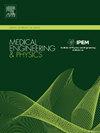增强辅助技术设计:外骨骼数据手套抓握策略优化的生物力学有限元建模
IF 1.7
4区 医学
Q3 ENGINEERING, BIOMEDICAL
引用次数: 0
摘要
本文试图改进外骨骼数据手套抓取策略的控制机制。设计了一种综合方法,将有限元数值模拟技术与外骨骼数据手套的计算机控制系统相结合,建立了一种新颖、精确的三维手部生物力学有限元模型。通过将有限元建模技术、生物力学理解和手部运动学相结合,提出了一种简单高效的虚拟抓取方法,动态地复制了三种典型的抓取动作。该方法可准确计算接触压力值,为外骨骼数据手套制定策略提供有价值的见解。实验验证了模型的仿真精度,比较了抓取任务中所有指尖的接触压力,证明了模型的高保真度。与依赖压力传感器和物理测量实验的传统方法相比,该方法具有方便、快速、低成本和提高精度等优点。所提出的有限元数值模拟模型为开发外骨骼数据手套的抓取策略提供了一个优化和可行的概念,促进了个人的精确抓取能力,并有助于提高他们的独立生活能力。此外,目前的模型侧重于复制典型的抓取动作,可能需要进一步发展,以涵盖更广泛的复杂物体形状和抓取动作。然而,这一发现对于外骨骼数据手套产品和系统的持续发展至关重要。本文章由计算机程序翻译,如有差异,请以英文原文为准。

Enhancing assistive technology design: Biomechanical finite element modeling for grasping strategy optimization in exoskeleton data gloves
This paper endeavors to enhance the control mechanisms governing the grasping strategy of exoskeleton data gloves. A comprehensive approach was devised, integrating finite element numerical simulation techniques with the computerized control system of exoskeleton data gloves, establishing a novel, precise, and three-dimensional biomechanical finite element model of the hand. By amalgamating finite element modeling technology, biomechanical understanding, and hand kinematics, a straightforward yet efficient virtual grasping methodology was introduced to replicate three typical grasping actions dynamically. This method accurately computes contact pressure values, offering valuable insights for formulating strategies for exoskeleton data gloves. Experimental validations were conducted to ascertain the model's simulation accuracy, comparing contact pressure across all fingertips during grasping tasks demonstrating the model's high fidelity. Compared to traditional methods reliant on pressure sensors and physical measurement experiments, this approach presents several advantages, including convenience, speed, low cost, and enhanced accuracy. The proposed finite element numerical simulation model presents an optimized and viable concept for developing grasping strategies in exoskeleton data gloves, facilitating precise gripping capabilities for individuals and aiding in enhancing their capacity for independent living. Furthermore, the current model focuses on replicating typical grasping actions and may require further development to encompass a wider variety of complex object shapes and grasping maneuvers. However, this finding is crucial to the ongoing evolution of exoskeleton data glove products and systems.
求助全文
通过发布文献求助,成功后即可免费获取论文全文。
去求助
来源期刊

Medical Engineering & Physics
工程技术-工程:生物医学
CiteScore
4.30
自引率
4.50%
发文量
172
审稿时长
3.0 months
期刊介绍:
Medical Engineering & Physics provides a forum for the publication of the latest developments in biomedical engineering, and reflects the essential multidisciplinary nature of the subject. The journal publishes in-depth critical reviews, scientific papers and technical notes. Our focus encompasses the application of the basic principles of physics and engineering to the development of medical devices and technology, with the ultimate aim of producing improvements in the quality of health care.Topics covered include biomechanics, biomaterials, mechanobiology, rehabilitation engineering, biomedical signal processing and medical device development. Medical Engineering & Physics aims to keep both engineers and clinicians abreast of the latest applications of technology to health care.
 求助内容:
求助内容: 应助结果提醒方式:
应助结果提醒方式:


